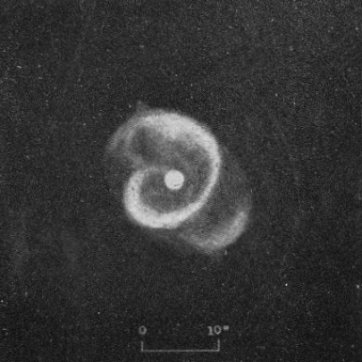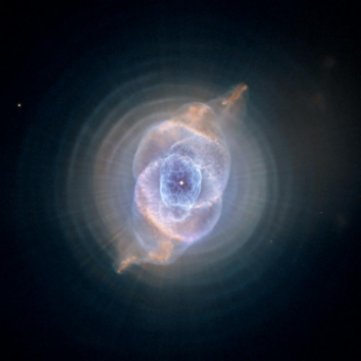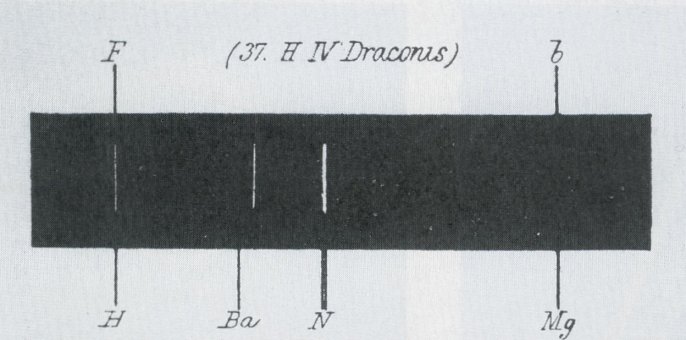NGC 6543
THE CAT'S EYE NEBULA
One of the brightest planetary
nebulae in the sky, NGC 6543 is of great historical
importance. The "first planetary," the one to which William
Herschel first applied the term, is the Saturn Nebula, NGC 7009 in Aquarius. But it was in the Cat's Eye, NGC 6543 in Draco, that he found the first known
central star. Herschel thought that he had discovered star birth, that the nebula was
condensing to form the star. While he had it backwards (the
nebula actually ejected by a dying star), his brilliance was in
that he understood that these objects had something to do with
stellar life cycles. The Cat's Eye was also the first planetary
nebula to have its spectrum examined, by
William Huggins in 1864. Listen to his words from his 1897
memoir, which reflect Herschel's ideas and reveal his thrill at
his great discovery:
"On the evening of August 29, 1864, I directed the
telescope...to a planetary nebula in Draco. The reader may be
able to picture to himself...the feeling of excited suspense,
mingled with a degree of awe, with which, after a few moments of
hesitation, I put my eye to the spectroscope. Was I not about to
look into a secret place of creation?
I looked into the spectroscope. No such spectrum as I expected!
A single bright line only! ...
The light of the nebula was monochromatic, and so, unlike any
other light I had yet subjected to prismatic examination, could
not be extended out to form a complete spectrum...A little closer
looking showed two other bright lines on the side towards the
blue. The riddle of the nebulae was solved. The answer, which
had come to us in the light itself, read: Not an aggregation of
stars, but a luminous gas" [emissions being characteristic of
hot gases under low pressure].
Huggins had discovered an emission line of hydrogen in the blue
part of the spectrum and two "mystery lines" in the green that
were later thought to come from an unknown element called
"nebulium." Among the strongest emissions in planetary nebulae,
the "nebulium" lines were finally found by I. S. Bowen in 1928 to
be emissions of doubly-ionized oxygen
On the left is Curtis's drawing. Made from several photographic
images, gives a sense of the object's visual appearance through
the telescope. On the right is the Hubble Space Telescope's view,
which shows vastly greater detail with intricate interlocking
rings and a stunning bipolar flow quite like the ansae seen in NGC
7009. With a decently known distance of 3000 light years
(determined from the expansion of the nebula coupled with the
expansion velocity of around 20 kilometers per second), the main
body of the nebula is some 0.4 light years across, while the twin
flows stretch out to about twice that distance. (One source,
however, suggests 5000 light years from the same data, showing how
tricky distance measures really are.) Surrounding the Cat's Eye
is a huge shell from earlier stellar winds with a diameter of
close to 4.5 light years, somewhat larger than the distance from
the Sun to Alpha Centauri. Concentric rings reveal episodic mass
loss. The ionic excitation is relatively low, as there is no
ionized helium. With a temperature of about 50,000 Kelvin, the
11th magnitude central star is still heating with a total
luminosity of around 1000 times that of the Sun.
Above is the simple drawing of the spectrum of NGC 6543 as seen
through the visual spectroscope of Sir William
Huggins in 1864. It shows the two forbidden oxygen lines at 5007
and 4959 Angstroms just to the right of center and to the far left
the H-Beta line of hydrogen, tagged "H" at the bottom. The tag
"F" at the top of H-Beta is a Fraunhofer designation applied
before any celestial (specifically solar) spectrum lines were
identified. An expected magnesium line (Fraunhofer "b") does not
show up. The forbidden lines were not identified as doubly
ionized oxygen until 1928, and were at the time thought to be from
nitrogen (hence the tag "N" at the bottom). See them in the
spectra of NGC 7009 and NGC 2440. The observations of the
emission lines proved for the first time that planetary nebulae
were gaseous. A similar observation of the Orion Nebula followed in 1872, showing that diffuse
nebulae were gaseous as well.
Image at left by H. D. Curtis from Publications of the Lick
Observatory, Volume 13, Part III, 1918. Right: NASA, ESA,
HEIC, and the Hubble Heritage Team (STScI/AURA). Quote and spectrum from
The Scientific Papers of Sir William Huggins, London:
William Wesley and Sons, 1909.




